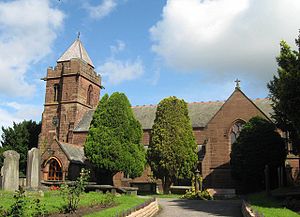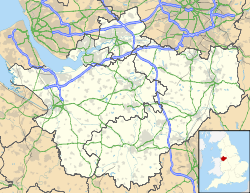- St James' Church, Christleton
-
St James' Church, Christleton 
St James' Church, Christleton, from the southLocation in Cheshire Coordinates: 53°11′08″N 2°50′18″W / 53.1856°N 2.8383°W OS grid reference SJ 440 657 Location Christleton, Cheshire Country England Denomination Anglican Website St James, Christleton Architecture Status Parish church Functional status Active Heritage designation Grade II* Designated 1 June 1967 Architect(s) William Butterfield Architectural type Church Style Gothic Revival Completed 1877 Specifications Materials Ashlar red and white sandstone
Green slate roofAdministration Parish Christleton Deanery Chester Archdeaconry Chester Diocese Chester Province York Clergy Rector Rev. K. Peter Lee Laity Churchwarden(s) David Mercer, John Eccles St James' Church, Christleton, is in the village of Christleton, Cheshire, England. The church has been designated by English Heritage as a Grade II* listed building.[1] It is an active Anglican parish church in the diocese of Chester, the archdeaconry of Chester and the deanery of Chester.[2] It is the only Cheshire church designed by William Butterfield.[3]
Contents
History
The name of the village is recorded in the Domesday Book and it is likely that a church was on the site at this time. In 1093 the patronage of the church was given to the monks of St Werburgh's Abbey, Chester. The church was rebuilt in stone around 1490, and the tower built at this time is still present. The church sustained considerable damage during the Civil War and around 1730 the nave and chancel were repaired. However during a service in 1873 the roof of the nave partly collapsed. Plans for rebuilding the church were prepared by Butterfield, retaining the 15th-century tower, adding gargoyles to each corner and a short spire to the turret.[4] The rebuilding took place between 1874 and 1878.[3]
Architecture
Exterior
The church is built in ashlar red and white sandstone with a green slate roof. Its plan consists of a nave and chancel in one range with a clerestory, north and south aisles, a south porch, side chapels to the chancel, and a west tower. The tower is in two stages with diagonal buttresses and a stair turret at the southeast angle. It has a three-light west window. The bell openings have two lights and are louvred. The parapets are embattled and have gargoyles. On top of the tower is a shingled pyramidal cap.[1]
Interior
The interior is decorated with red and white sandstone with a chequerboard pattern added in the upper portion.[1] There is no chancel arch, but between the nave and the chancel is a tympanum marking the division.[3] In the chancel is a large alabaster reredos having panels filled with mosaic.[1] The chancel is floored with Minton tiles.[3] The west window dated 1877 is by Gibbs and much of the other stained glass is by the firm of Kempe, and is dated between 1884 and 1904.[1] In the north aisle is a window dating from about 1986 by Cliff Boddy, and there is a window celebrating the 2000 millennium in the south transept by Bill Davies.[3] A large painted panel of the royal arms dated 1665 is by Randle Holme III.[1] The font is made from Sicilian marble on a Derbyshire limestone base. The churchwardens' benches have canopies. The altar table is Jacobean. Also in the church is a carving of a pelican feeding her young with her own blood, and an old village constable's staff.[4] The two-manual organ was built by Holdich, and rebuilt around 1990 by Rushworth and Dreaper.[5] The ring is of eight bells cast in 1928 by John Taylor and Company.[6]
External features
In the churchyard is an ashlar red sandstone sundial from the mid-late 18th century,[7] and the headstone of William Huggins and members of his family dated 1884.[8] Both of these are listed Grade II. Also listed Grade II is the lych gate which was designed by Butterfield and is built from ashlar red sandstone and timber framing with a Welsh slate roof and a red tile ridge.[9]
References
- ^ a b c d e f "Church of St James, Christleton", The National Heritage List for England (English Heritage), 2011, http://list.english-heritage.org.uk/resultsingle.aspx?uid=1330249, retrieved 1 May 2011
- ^ St James, Christleton, Church of England, http://www.achurchnearyou.com/christleton-st-james/, retrieved 1 May 2011
- ^ a b c d e Hartwell, Claire; Hyde, Matthew; Hubbard, Edward; Pevsner, Nikolaus (2011) [1971], Cheshire, The Buildings of England, New Haven and London: Yale University Press, pp. 288–289, ISBN 978-0-300-17043-6
- ^ a b Brief History of St James' Church, St James, Christleton, http://www.btinternet.com/~saint.james/Page2.Html, retrieved 15 January 2008
- ^ Christleton St. James, British Institute of Organ Studies, http://www.npor.org.uk/cgi-bin/Rsearch.cgi?Fn=Rsearch&rec_index=N04351, retrieved 13 August 2008
- ^ Christleton S James, Dove's Guide for Church Bell Ringers, http://dove.cccbr.org.uk/detail.php?searchString=christleton&Submit=++Go++&DoveID=CHRISTLETO, retrieved 13 August 2008
- ^ "Sundial in St James Churchyard, Christleton", The National Heritage List for England (English Heritage), 2011, http://list.english-heritage.org.uk/resultsingle.aspx?uid=1130670, retrieved 1 May 2011
- ^ "Headstone of William Huggins, St James Churchyard, Christleton", The National Heritage List for England (English Heritage), 2011, http://list.english-heritage.org.uk/resultsingle.aspx?uid=1187247, retrieved 1 May 2011
- ^ "Lychgate to St James Churchyard, Christleton", The National Heritage List for England (English Heritage), 2011, http://list.english-heritage.org.uk/resultsingle.aspx?uid=1187242, retrieved 1 May 2011
Categories:- Church of England churches in Cheshire
- Grade II* listed churches
- Grade II* listed buildings in Cheshire
- English Gothic architecture
- Gothic Revival architecture in Cheshire
- Diocese of Chester
Wikimedia Foundation. 2010.

